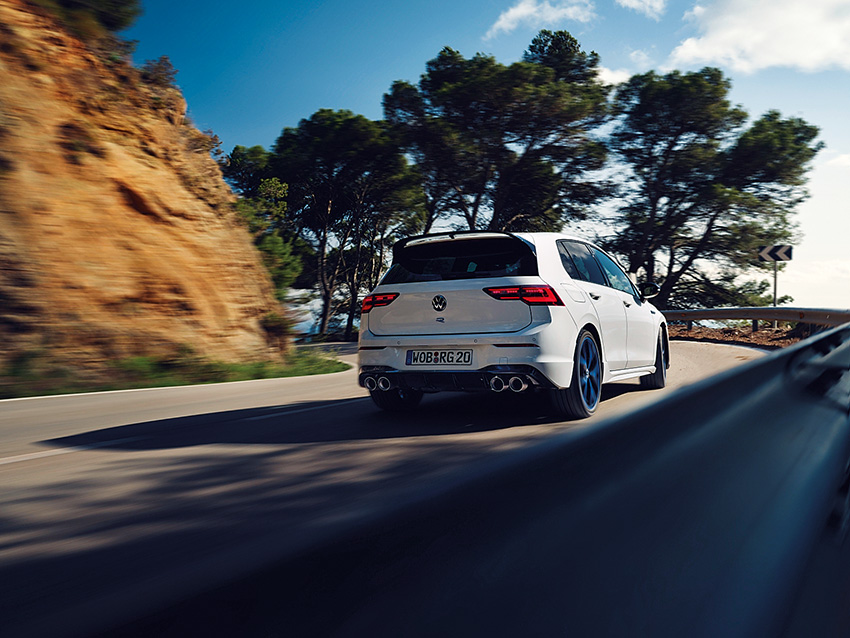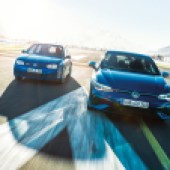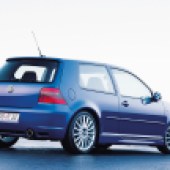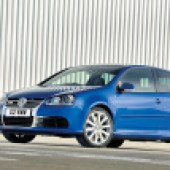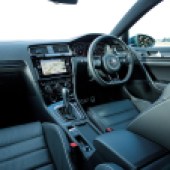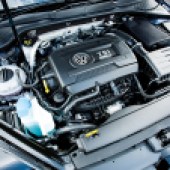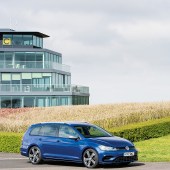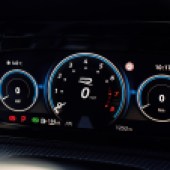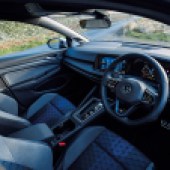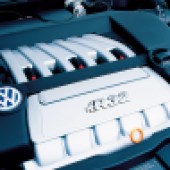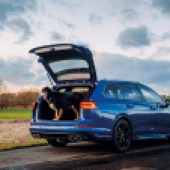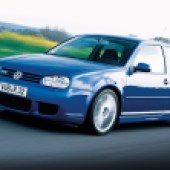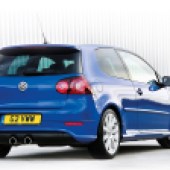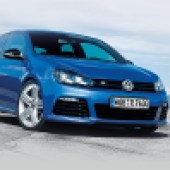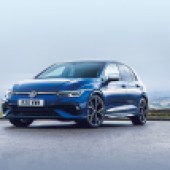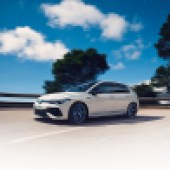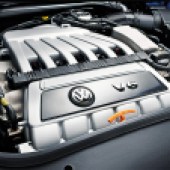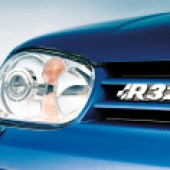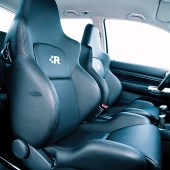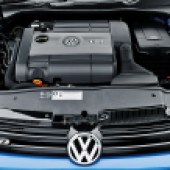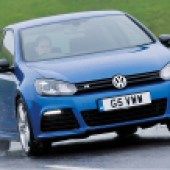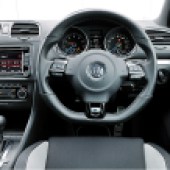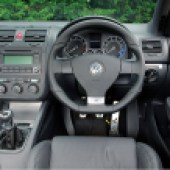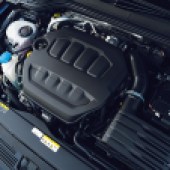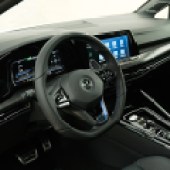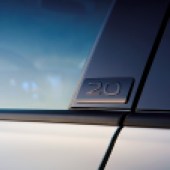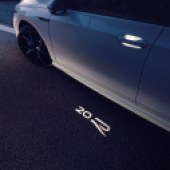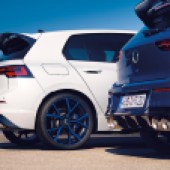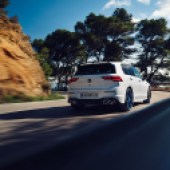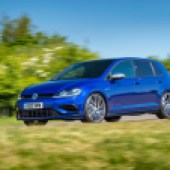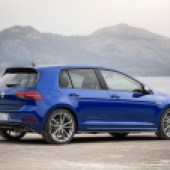The VW Golf R has come a long way in the two decades since the debut of the Mk4 Golf R32. With a new special edition model out now celebrating its 20th anniversary, here’s our ultimate guide to the VW hot hatch.
For a great many years the high-performance flagship for Volkswagen was the Golf GTI in its many forms, covering four generations and numerous variations on the theme, from the 110hp 1.6-litre of the original Mk1, through 136PS with the Mk2 16v and 150hp with the Mk3 16v, up to the 180hp of the turbo 1.8-litre 20v in the later versions of the Mk4.
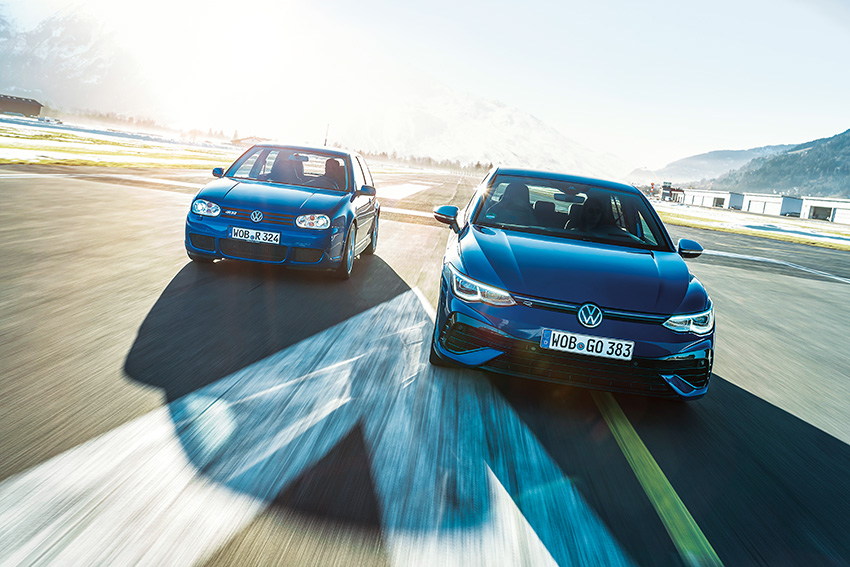
The GTI developed still further with the Mk5 version in 2004, with many arguing that it was effectively re-incarnated with the 200hp turbocharged 2.0-litre 16-valve engine, but events in the early years of the millennium saw that it was no longer the leader of the pack.
We’d already seen the advent of the 2.8-litre VR6 engine in the Passat and the Mk3 Golf (and Vento) in the Nineties, but that wasn’t so much a hot hatch as an executive express. The six-cylinder theme was taken a step further with the Mk4 Golf V6 4Motion in 2000, combining the 204PS 2.8-litre 12v engine with the new Haldex four-wheel drive system to win the accolade of Towcar of the Year. It was an impressive all-rounder, but we still weren’t quite there for the title of ultimate hot hatch.
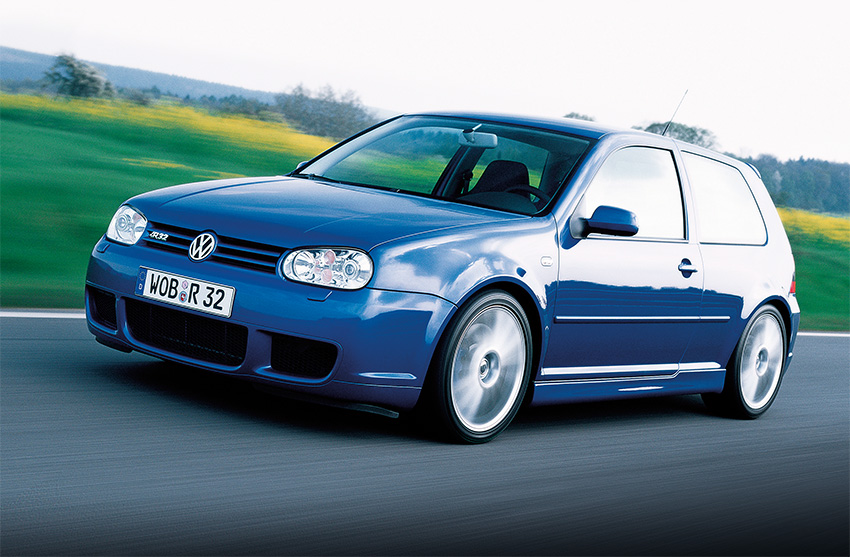
VW Golf R32 Mk4
The so-called ultimate hot hatch arrived in 2002 when Volkswagen pulled the wraps off what would soon become a legend in its own lifetime, the Mk4 Golf R32. Hailed as ‘the fastest production Golf to date’, the R32 was also the most overtly sporting model so far produced, with its narrow-angle 24-valve 3.2-litre VR6 engine developing 240hp at 6250 rpm and maximum torque of 320 Nm between 2800 and 3200 rpm.
With the additional benefit of four-wheel drive, that 40hp bonus over the GTI was not only good for a 0-62 mph sprint time of just 6.6 seconds and a top speed of 153 mph, but the six cylinders also produced a distinctively guttural engine note and a robustly rorty exhaust note from its twin chrome tailpipes.
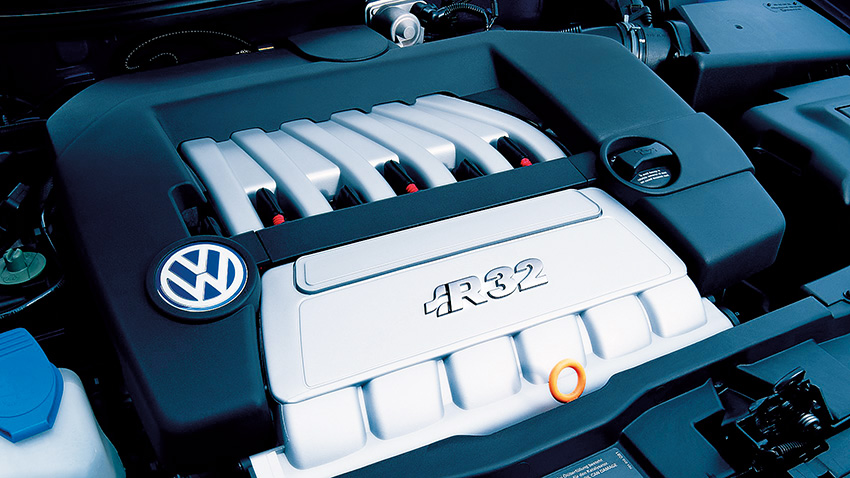
The R32 also had the drivetrain and chassis to match, with a 6-speed manual gearbox harnessed to the Haldex coupling four-wheel drive system, suspension lowered by 10 mm compared with the standard Golf V6, along with uprated dampers, bigger brakes, more responsive steering and the ESP handling modulation system. New 7.5×18” multi-spoke ‘Aristo’ alloy wheels, shod with 225/40 high-performance tyres completed the dynamic qualifications.
In stark contrast to the almost standard appearance of the Mk4 Golf V6, the R32 was much more aggressively styled. Available in both three- and four-door configuration, in three colours, Reflex Silver metallic, Diamond Black and Deep Blue pearl metallic, it came with new deeper front and rear bumpers, side sills, blue brake callipers and silver ‘R32’ badges on the grille and tailgate. Inside, aluminium trim, bolstered sports seats with integrated backrests and extensive use of the ‘R’ logo provided even further sense of occasion for the R32 pilot.
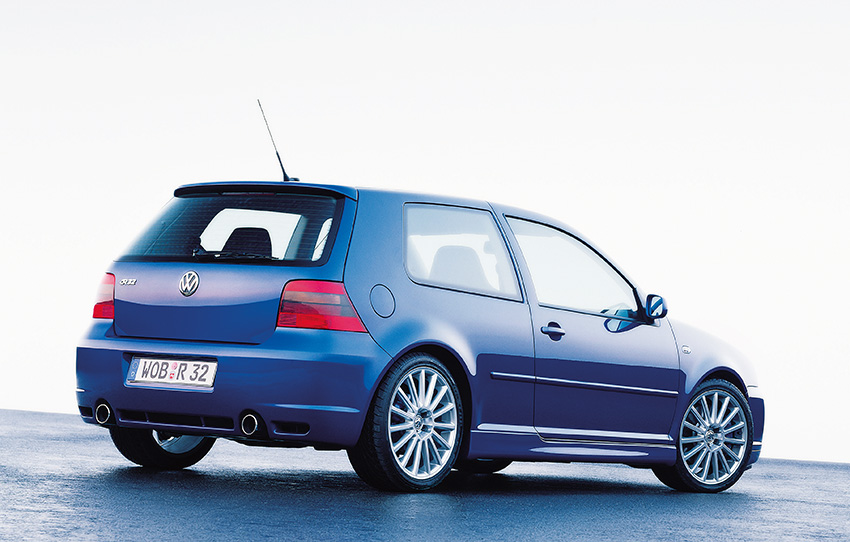
Needless to say, the R32 soon became ‘the car to have’, providing a unique blend of high-performance, superb handling, all-weather capability and everyday practicality, with over 2300 finding homes here in the UK. Inevitably, many examples were soon upgraded even further by the tuning companies to provide supercar performance levels, although a completely standard example might be more highly sought-after as a modern-day classic.
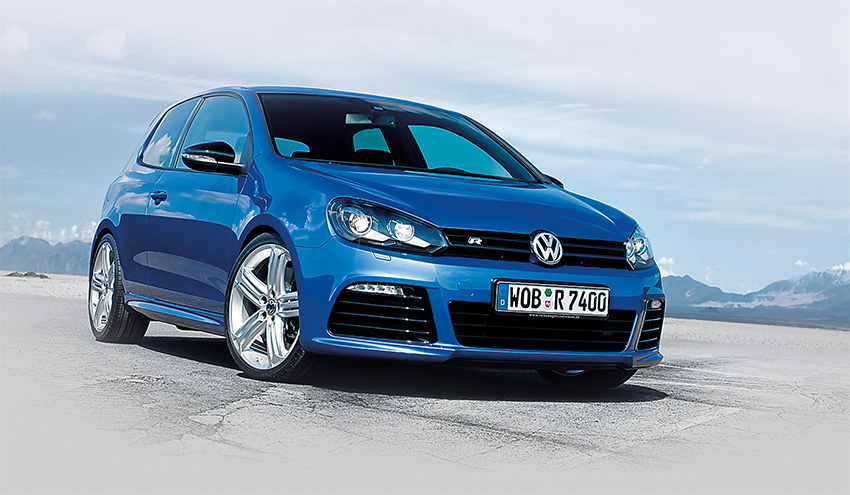
VW Golf R32 Mk5
Substantial though the Golf R32 was, it was still based on the Mk4 Golf which, after five years, was starting to become dated. The advent of the Mk5 Golf in 2003 brought with it a substantially improved GTI in 2004 and the R32 version followed soon after, in late 2005.
Although the Mk5 version came with a slightly softer look than its predecessor – it was likened at the time to the difference between the Demon Tweeks motorsport and the road styling catalogues – it was no less capable…
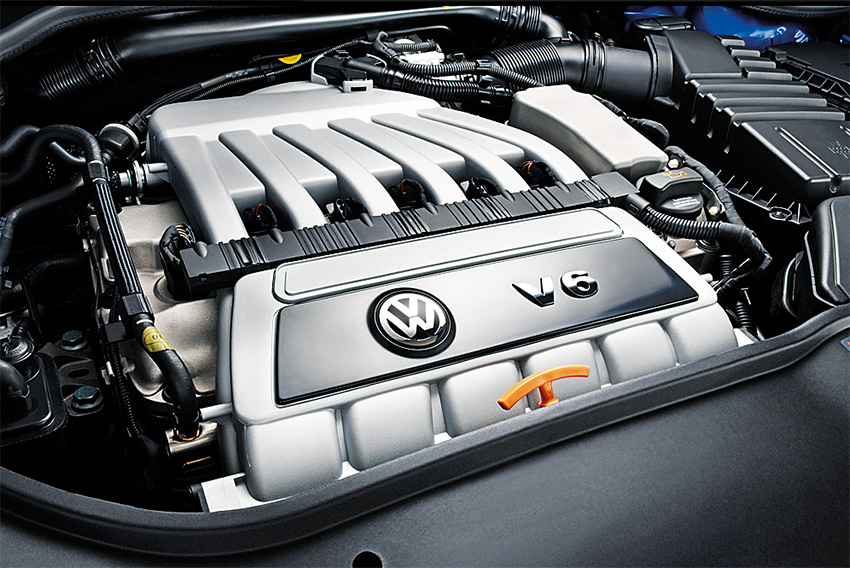
The 3.2-litre VR6 engine was uprated to 250hp at 6300 rpm, the extra 10hp due to a reworked inlet manifold, with torque at the same 320 Nm. Now available with either 6-speed manual gearbox or the new DSG automatic transmission, official acceleration figures were 6.5 secs for the manual and 6.2 for the DSG, with the top speed governed at 155mph (250 kph).
As previously, the new R32 came with the Haldex-based 4Motion four-wheel drive system, along with uprated suspension and bigger brakes, now fitted with 18” Zolder 20-spoke alloy wheels.
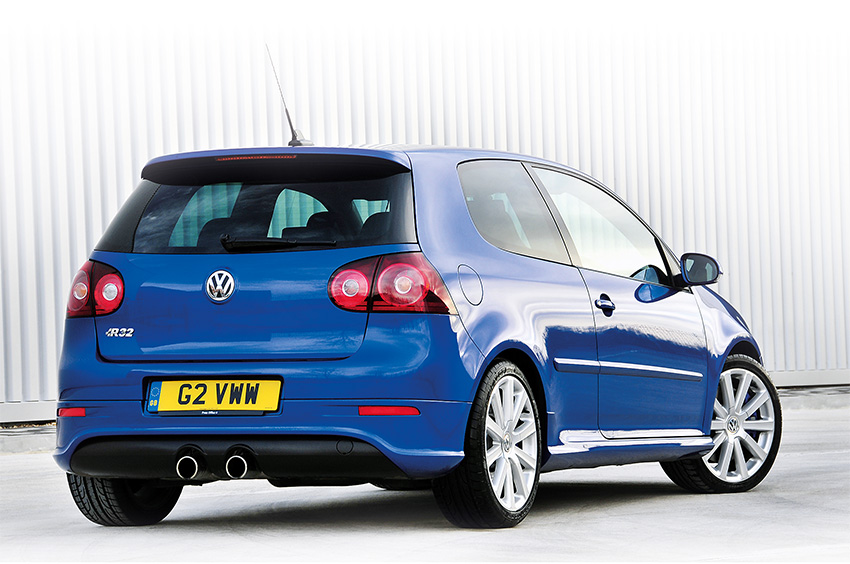
Although not quite as aggressive looking as its predecessor, the new R32 was distinguished from all other models in the Golf range by a new front bumper with imposing air intakes, a bold polished aluminium full-width grille, darkened rear lenses and a full-depth painted rear bumper with a black mid section housing centrally-positioned twin exhaust pipes.
Inside, highlights included distinctive instrumentation, sports seats, aluminium pedal trims, leather-trimmed gearknob and steering wheel, with racing-style Recaro bucket seats offered as an option. Standard equipment included bi-xenon headlights, 2Zone Climatronic air conditioning, a 10-speaker audio system and rain sensor wipers with auto-dimming rear view mirror.
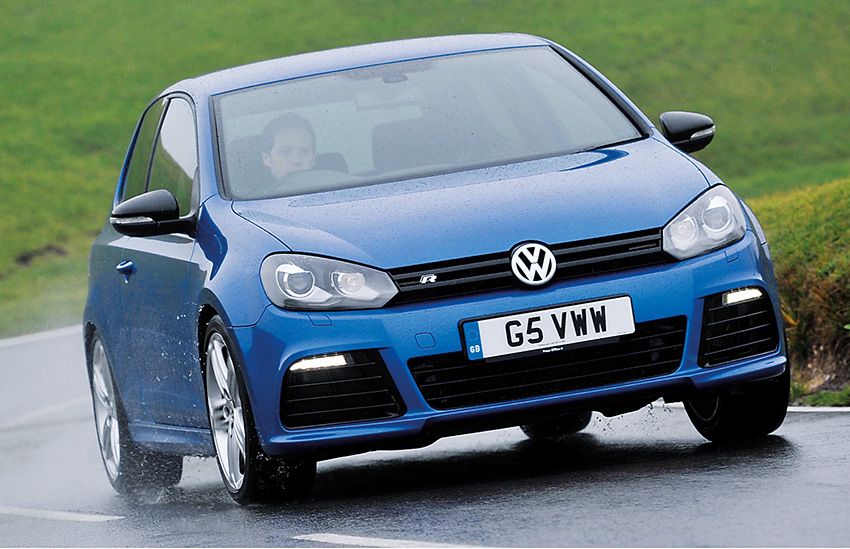
VW Golf R Mk6
For those addicted to the unique character and sound of the naturally aspirated six-cylinder 3.2-litre engine, the Mk6 Golf R – which was released in 2010 – was initially somewhat of a disappointment, now powered by a 2.0-litre four-cylinder turbo unit. Then we realised that it was more powerful, faster, handled better and was more fuel-efficient. What was not to like?!
Now powered by an uprated version of the EA113 series 2.0-litre direct-injection TSI engine used in the GTI, the Mk6 Golf R was not only the most powerful so far, with 270hp and 350 Nm torque over a broad range from 2500 to 5000 rpm, but it was also 20 per cent more fuel efficient than the 3.2 VR6.
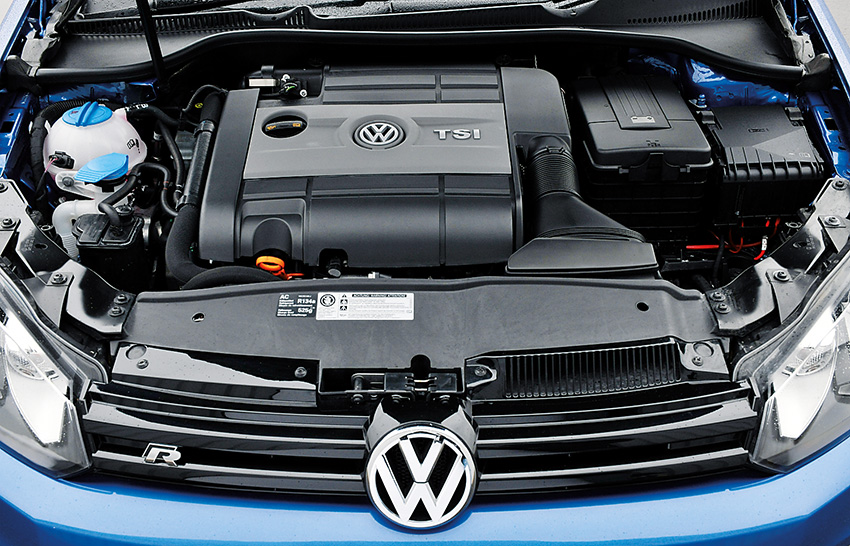
In conjunction with either 6-speed manual or DSG and an uprated Haldex four-wheel drivetrain, it could accelerate from 0 to 62mph in 5.7 seconds (manual) or 5.5 (DSG) with the top speed limited to 155mph, and was capable of average fuel consumption of 32 mpg.
Although the chassis of the Mk6 version is essentially the same as the Mk5, with the ride height reduced by 25 mm and uprated springs, dampers and anti-roll bars, the Mk6 R now came with the option of Dynamic Chassis Control (DCC). This continually adapts the damping and power steering to suit the road and driving situation, while also allowing the driver to manually activate a Sport or Comfort mode. The electronic stabilisation program (ESP) could also be switched to a new Sport mode to delay intervention.
New 7.5×18” alloy wheels, a style called Talladega, with 225/40 tyres, were standard equipment, also available in a 19” version with 235/35 tyres as an option. The R also featured black brake callipers with the R-logo.
A new front bumper design featured three large air intakes with the louvres in high-gloss black, with standard LED strips that serve as daytime running lights integrated in the two outer air intakes. High-gloss black louvres in the radiator grille contrasted with the chrome R logo on the right side. Bi-Xenon headlights with dynamic cornering light were standard.
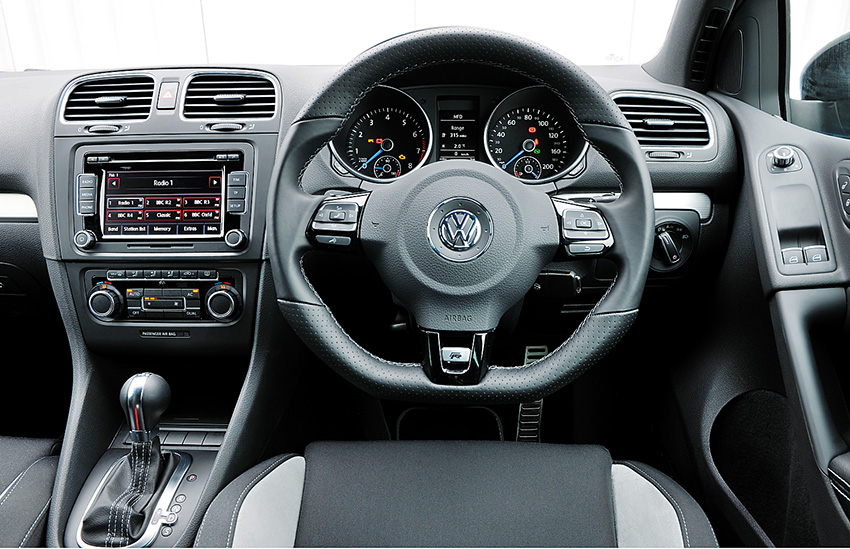
The new Golf R also featured body-coloured side skirt extensions, door mirror housings in high-gloss black, tinted rear lights, a rear bumper with diffuser and centrally positioned tailpipes, R-logo and a larger roof edge spoiler.
Inside were fully adjustable Sports seats with the centre panels upholstered in the honeycomb textured grey-black ‘Kyalami’ design, the side supports upholstered with crystal-grey ‘San Remo’ microfibres. The rest of the seat components and the headliner were coloured black. The new R-logo was embroidered in the front head restraints as well. Motorsport-style shell seats for driver and front passenger were also available as an option.
Also re-styled were the R gearshift knob, carpet floor mats with piping in ‘Art Grey’, aluminium door tread plates with R-logo, stainless-steel sport pedals and R-specific instrument and door accents in ‘Silver Lane’ and the instruments with their blue pointers. Standard equipment also included a Climatronic automatic climate control system and an RCD 310 radio-CD system (4 x 20 Watt) with MP3 player plus dual tuners.
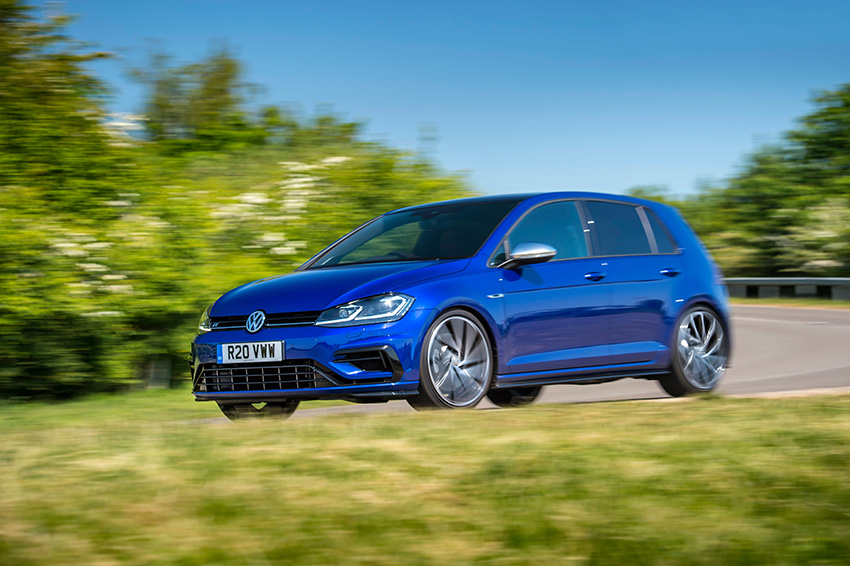
VW Golf R Mk7
As good as it was, the Mk6 Golf R was still based on the same basic architecture as the Mk5 Golf, but Volkswagen had been busy developing a brand-new platform for the next generation, the MQB…
Early 2013 saw the flagship VW Golf R, powered by a development of the four-cylinder 2.0-litre EA888 engine used in the GTI. Output was boosted from 230 to 300 PS (from 5500 to 6200 rpm) and maximum torque by 30 Nm to 380 Nm over a broad range from 1800 to 5500 rpm, so this engine was both powerful and highly flexible in delivery.
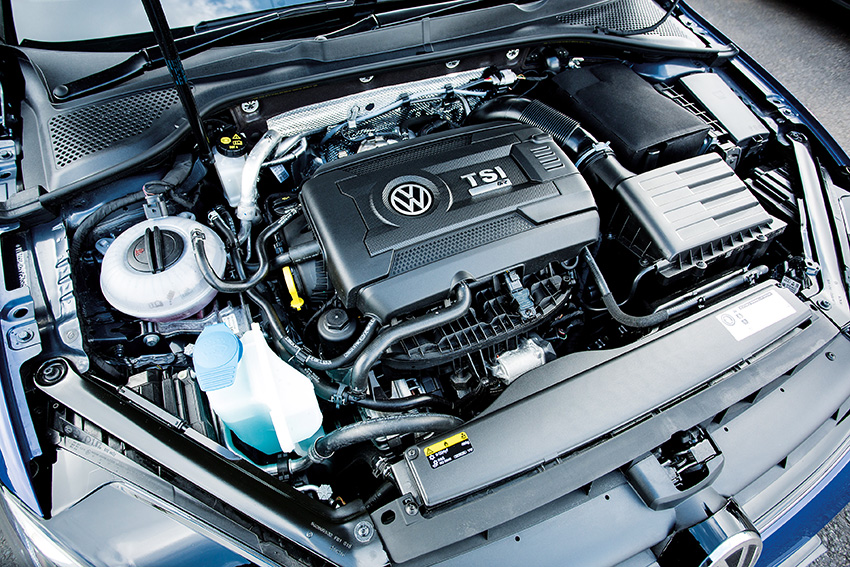
Permanent all-wheel drive, always a trait of the Golf R, now used the latest generation Haldex system, activated even before any wheel starts to slip. With the 6-speed manual the 7R could achieve 0 to 62 mph in 5.1 seconds; with the DSG auto it was even faster at 4.9 seconds. The top speed of both is electronically limited to 250 kph (155 mph). Fuel consumption and emissions were improved by a further 18 per cent in the new car, too.
With such supercar performance in a road car the Golf 7R featured a sports suspension set-up lowered by 20 mm, compared to the standard Golf, and 5 mm lower than the GTI. In addition to the Haldex coupling, electronic differential locks (EDS) act as transverse locks at both front and rear, briefly braking any wheel that is slipping, to transfer drive power to the opposite side. It was also equipped with XDS+ at front and rear, braking the wheels on the inside of a bend to compensate for understeer during fast cornering.
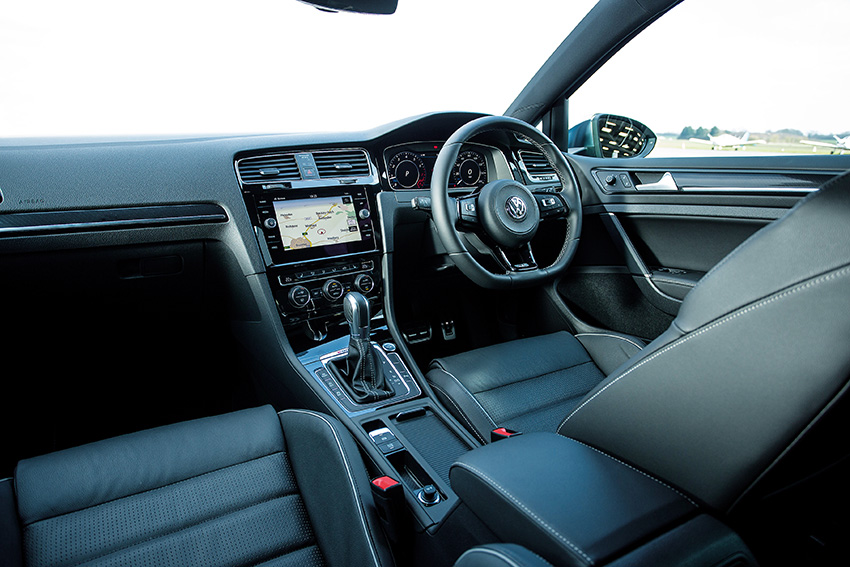
The 7R was also equipped with the ESC Sport function, activated by a two-stage switch on the centre console. This introduced a delay for even more agile handling properties, and could also be fully deactivated ‘for professional driving on a race track’. Now you’re talking…
The new Golf R could be ordered with dynamic chassis control (DCC) as an option, offering Comfort, Normal and Sport settings in the Driving Profile Selector (DPS), providing good ride quality as well as supreme handling ability. In conjunction with DCC, the DPS could also provide Eco, Normal, Individual and a specially tailored Race program, unique to the Golf R.
The Golf 7R featured specially designed bumpers, side sills, R badges on the front wings, Matt chrome door mirror housings, 18-inch Cadiz alloys with 225/40 tyres, standard bi-xenon headlights with LED daytime running lights, dark red LED rear lights and a two-branch exhaust system with four chrome tailpipes, two at either side of the central diffuser.
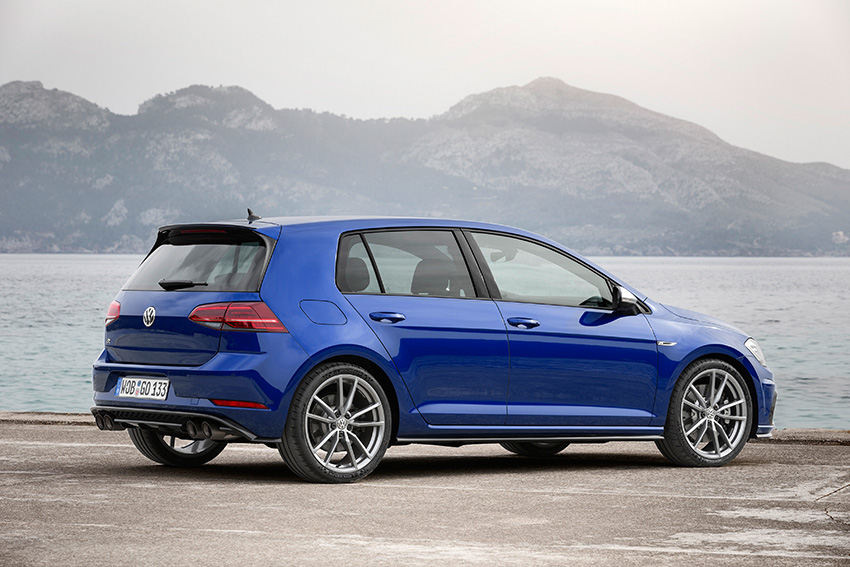
Inside, it featured sport seats in cloth/Alcantara with an R logo embossed on the seat backrests, leather-trimmed three-spoke sport steering wheel, ambience lighting, automatic climate control and a radio-CD system with touchscreen.
It all added up to a car which provided phenomenal all-weather performance and handling along with reasonable fuel economy and everyday practicality. The Golf 7R could still return 30 and as much 40 mpg when driven conservatively. Little wonder that it soon became extremely popular with a wide range of drivers, above and beyond the traditional enthusiasts of the hot hatch GTI.
Introduced in 2015, the Mk7 Golf R Estate only added to the appeal, with the greater practicality of four doors and the capacious estate bodyshell, along with similar features and specification and very little if any loss of dynamic capability. The ultimate dog hauler…
The Mk7.5 facelift at the beginning of 2017 saw the power output for both hatchback and estate models increased further to 310 hp, reducing the 0-62 mph time to a staggering 4.9 seconds, while the top speed remained limited at 155mph, although 168mph could be achieved with the optional Performance package which was a bit of a must.
At the end of 2018, due to emissions controls, the power output reverted to 300hp although strangely, the actual performance was hardly affected.
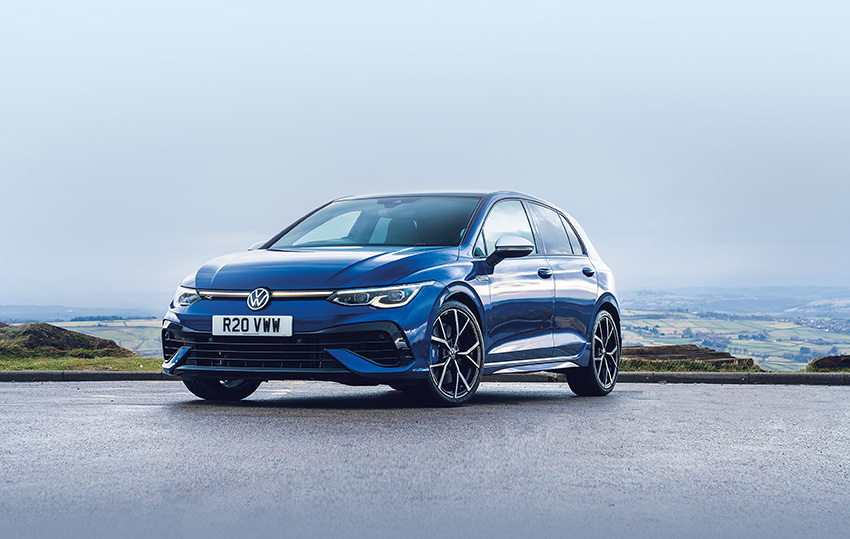
VW Golf R Mk8
Now, with the eighth generation of the Golf range, the R model is available in both four-door hatchback and estate body styles from launch (three-door option finally dropped), both now only with the 7-speed DSG transmission.
Even faster than before, the EA888 evo4 2.0-litre four-cylinder direct-injection petrol engine now has peak power of 320PS and maximum torque of 420 Nm, along with a new 4MOTION all-wheel drive system which provides torque vectoring on the rear axle. This distributes the drive power not just between the front and rear axles, but also between the two rear wheels, significantly increasing the agility of the Golf R, particularly when cornering.
The Golf R can also be ordered with an optional R Performance Package, which increases the top speed to 168mph (270kph). It also includes a larger, prominent rear spoiler for extra downforce at the rear, 8×19” Estoril alloy wheels and two additional driving profiles, ‘Special’ (Nürburgring mode) and ‘Drift’, activated by pressing the R button on the steering wheel.
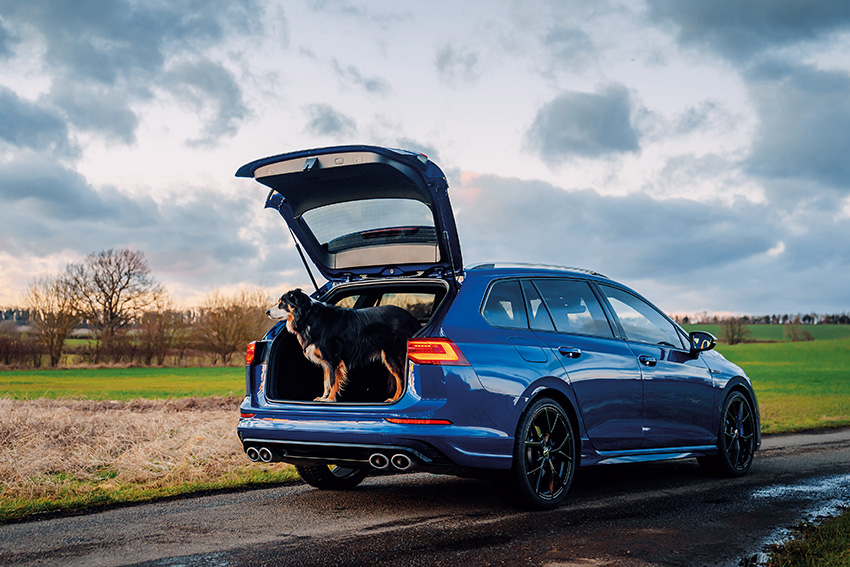
Intended for use on track days, Drift mode makes use of the torque vectoring to provoke oversteer instead of the normal neutral vehicle handling, permitting drifting by making the maximum possible torque available on the rear wheel on the outside of the bend.
In both Special and Drift mode, the gearbox calibration has been optimised in order to keep the rpm consistently high. In automatic mode, the DSG switches up as late as possible and down as early as possible, to aid power development. The gearbox will remain in manual control in both modes if the driver has selected this, no longer slipping back into automatic mode.
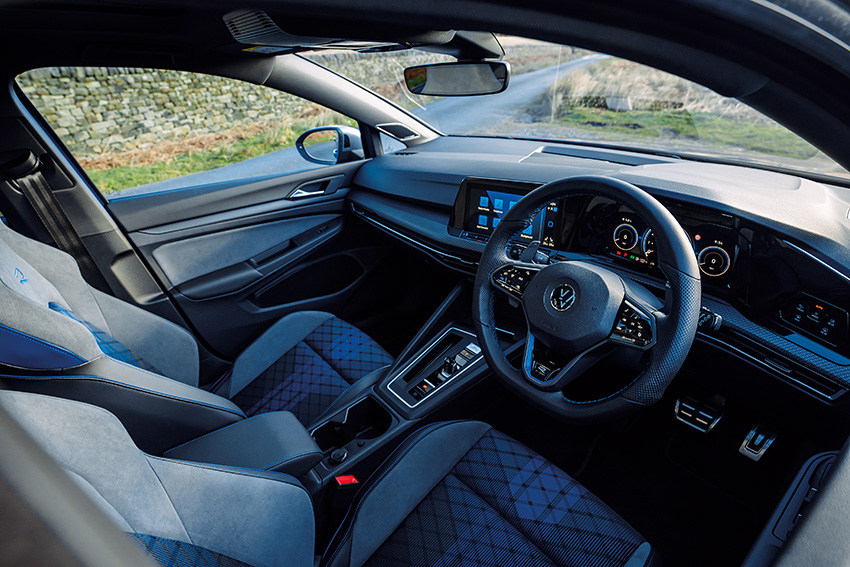
It remains to be seen whether the R concept will be extended into future generations as the model mix moves increasingly towards electric power, but it seems entirely feasible that a high-performance all-wheel drive model of the future could use electric motors all around. The only thing missing will be the evocative engine note…
Check out our Mk8 Golf R modifications guide.

VW Golf R Mk8 20 Years Edition
With two decades having passed since the original R32 was introduced in 2002, Volkswagen is celebrating the occasion with the release of a new one-year only special edition Golf R called the ‘20 Years Edition’. As well as performance upgrades and dynamic improvements the new model also features several cosmetic enhancements.
Technically the new model is fundamentally the same as the R-Performance pack-equipped VW Golf R, including the R-Performance Torque Vectoring feature in conjunction with the Vehicle Dynamics Manager and two additional driving modes, Special and Drift.

Even more importantly the 2.0-litre turbo engine has been uprated to produce a maximum power of 333PS, some 13 PS more than the current Mk8 VW Golf R, making it now capable of sprinting from 0 to 62 mph in just 4.6 seconds, with the restricted top speed now extended to 168mph (270 kph).
A special feature is a new ‘Emotion Start’ system which flares the engine up to 2500 rpm on start-up. The engine and gearbox response have also been enhanced, with the turbocharger preloaded at a constant speed during part-load driving to provide more instantaneous reaction when back on the power. The DSG also offers more aggressive manual shifts in the sportier S and S+ gear selector positions, providing a more urgent reaction from the gearbox and drive train when the right-hand paddle shifter is operated, further encouraging a more dynamic driving experience.
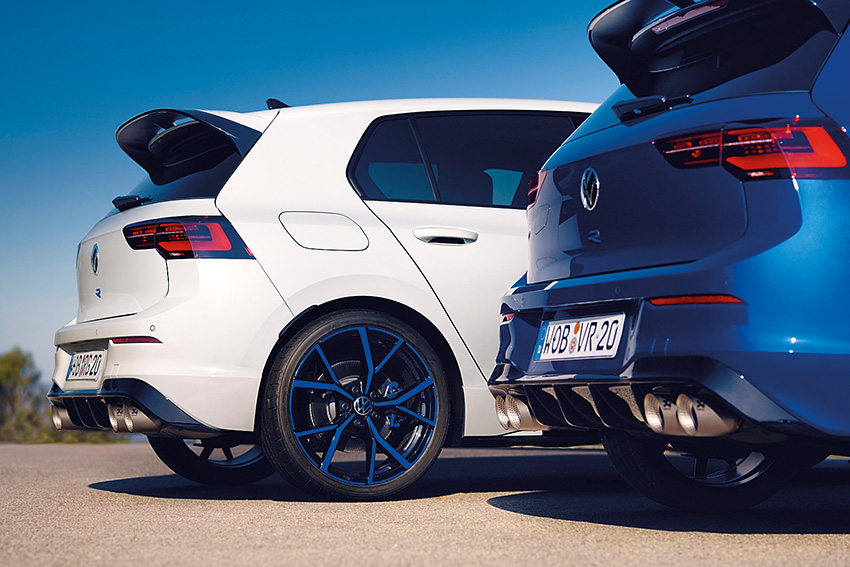
External features include a set of 8×19” Estoril alloy wheels, finished either in plain black or black with a blue surface finish, fitted either with 235/35 R 19 high-performance tyres or with the option of 235/35 R 19 semi-slick tyres.
The black radiator grille prominently features the blue R-logo, also found on both wings and at the rear, and there’s a unique ‘20’ badge on the B-pillar along with a ‘20 R’ puddle light which displays when unlocking the car.
Inside, the Golf R 20 Years features as standard premium sport seats trimmed in Nappa leather, carbon-fibre dashboard and door panel inserts, along with blue R branding on the steering wheel, sports seats and key fob.
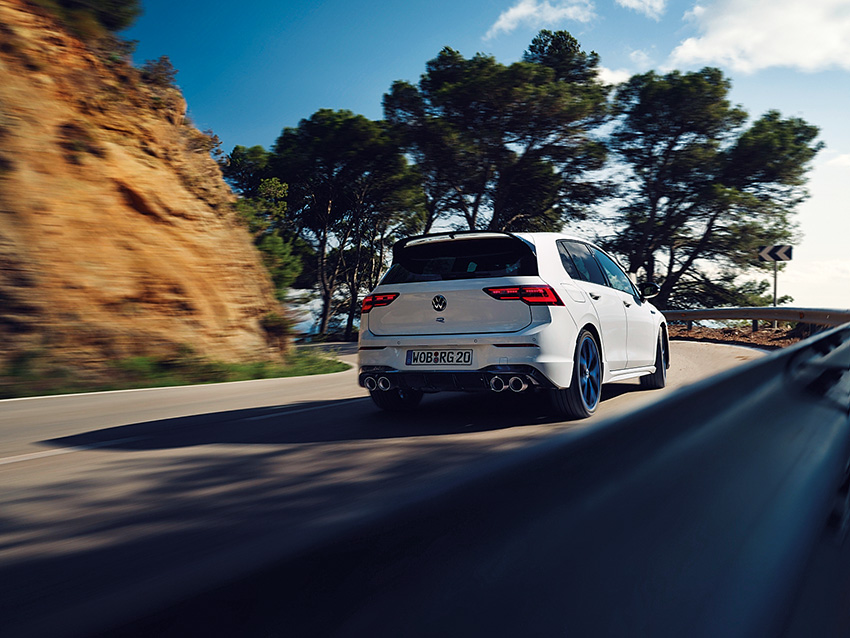
VW Golf R and R32 images
Guide from Performance VW magazine. Words: Neil Birkitt Pics: Volkswagen AG.

